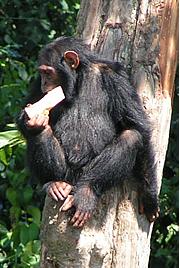 Moden chimps may follow the eating rituals of their ancestors. Click here to see which other animals use tools.Narelle Towie/nt
Moden chimps may follow the eating rituals of their ancestors. Click here to see which other animals use tools.Narelle Towie/ntIn the West African rainforest, archaeologists have found ancient chimpanzee stone tools thousands of years older than the previous oldest finds in the same area. The discovery suggests that chimps may have passed cultural information down the generations for more than 4,000 years.
The human fossil record dates back 2.6 million years, thanks to our ancestors' who lived in more arid areas, where bones are well preserved. But the chimp fossil record is very sparse. We know little about ancient chimps' lifestyles, and only one previous set of old tools, dating from 100 years ago, has been found1.
Both sets of tools consist of stones used to smash open the nuts of the panda tree (Panda oleosa), and the flakes of stone chipped off by this hammering. They were found in the same spot of rainforest in the Côte d'Ivoire. The recently discovered set is dated to 4,300 years ago, researchers report in Proceedings of the National Academy of Sciences2.
"What makes this find interesting is that the rocks are so old," says Huw Barton, an archaeologist from the University of Leicester, UK. We have no idea how far back such tools were used, he adds: "For all we know stone tool use behaviour could be very ancient."
Although panda nuts are found across Africa, only West African chimps (Pan troglodytes) have been seen cracking them with rocks, using a piece of granite and steadying the nut against a cracking post, usually the nook of a tree stump.
Chimps' rock
ADVERTISEMENT
Julio Mercader from the University of Calgary in Canada and his colleagues dated the flakes of rock that they found by studying radioactive elements preserved in the soils.
To show that the fossils were chimp tools, rather than human ones or the result of natural wear, they asked experts to identify a mixture of naturally fractured stones, human stone tools, or a purported chimp artefact. The experts classified the rocks the same way more than 70% of the time.
The team also analysed nut starch on the stones, to show that they had been used on panda nuts. "The type of starch on the pounding tools was nearly all from nuts that are eaten by chimps and not by humans," says Barton.
How tool use arose — and whether chimps copied it from humans— remains a mystery. "It's quite possible that type of behaviour has risen independently amongst chimapanzees and humans," says Barton. "We don't know and maybe we will never know, but the implications are very exciting," he says.
Visit our chimptoolsfoundin_we.html">newsblog to read and post comments about this story.
